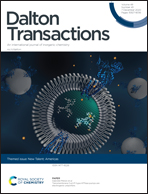Tunable carbocation-based redox active ambiphilic ligands: synthesis, coordination and characterization†
Abstract
The synthesis of novel redox active ambiphilic ligands L1–L3 and their coordination chemistry to first-row late transition metal halides (M = Co and Ni) is reported. The heterocyclic carbocation scaffolds act as Lewis acid moieties while the pyridine anchor acts as the coordinating Lewis base. The high synthetic tunability of this ligand scaffold allows for control of its rigidity and electronic properties. Anion exchange and coordination of a chloride anion to the metal center was observed resulting in the formation of [MCl3]− metallate. Upon coordination to the pyridine anchor, the metallate centers adopt a canonical tetrahedral geometry, resulting in an overall neutral complex best described as a zwitterionic metallate trichloride bound to a cationic ligand. Characterization techniques including single crystal X-ray diffraction, cyclic voltammetry, and UV-Vis absorption spectroscopy were employed to better understand the structural and chemical properties of the ligands and metal complexes. A possible weak interaction between one of the chlorides and the carbenium moiety in the ligand is observed in crystals of both of the Co(II) and Ni(II) complexes with ligand L1. Density functional theory (DFT) calculations support that this electrostatic interaction for complexes 2a and 2b exists only in the solid state.

- This article is part of the themed collection: New Talent: Americas


 Please wait while we load your content...
Please wait while we load your content...